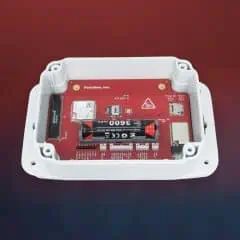Two-factor user authentication
You can now enable two-factor authentication (2FA) for your administrators, resellers, and customers to significantly increase access security.
With 2FA, users must enter a time-sensitive password (OTP) after entering their usual username and password to log in to the system. The secure OTP is generated by a 2FA application, such as Google Authenticator, that is installed on the user’s smartphone.
2FA is available on the new, subscription-based PortaOne cloud PBX self-care portal. The standard, built-in customer self-care portal that comes packaged with PortaBilling does not support 2FA. You can, however, add 2FA to third-party self-care portals, as the PortaBilling API supports it.
What’s improved?
Increased security level
Protect access to your system with an additional security layer.
Compliance with security policies
Meet the requirements for security audits.
Find more details here.
GST assessment for Singapore
You can now assess the Goods and Services Tax (GST) for your customers in Singapore based on the current rate set by the government. As GST is levied only on services consumed domestically, PortaBilling automatically applies this rate to domestic service (calls and messages made within Singapore) and a rate of zero to international service (e.g., when a user from Singapore makes a call or sends a message to a non-Singapore number).
To prepare for upcoming changes to the GST rate in Singapore, you can easily pre-set a new rate with an “effective from” date (for example, apply a rate of 8% starting from January 1, 2023), and the new rate will be automatically applied starting from the desired date.
What’s improved?
Ensure tax compliance
Assess GST according to Singapore tax regulations.
Find more details here.
Control how call-queue calls are dispatched to busy agents
Larger centers with lots of agents on staff usually want to avoid disturbing or distracting agents who are already on a call with a customer, and so prefer to have incoming calls directed to an available agent or call queue until an agent finishes their current call and can handle the next one.
However, small businesses that have ad-hoc call centers with only a few agents may want to direct incoming calls to agents even when they are on the phone, so that, for example, they do not miss a call from a prospect. Say Peter, a sales agent in a shop, is on the phone, and he is notified by the “call waiting” feature that another call has arrived. He sees that nobody else can currently handle this call and knows that if it’s not picked up soon the caller may just hang up.
So, Peter puts the current call on hold and switches to the other call, asking the caller to leave their contact data so he can get back to them later.
With MR103, you can switch between these two call-queue modes and decide whether or not to dispatch calls to busy agents, depending on your specific needs.
What’s improved?
Flexibility in call queue management
Choose how calls are dispatched to agents depending on traffic levels or call center size.
Find more details here.
Protection against brute-force attacks via SSH
Now, it’s possible to protect access to the system from “brute-force attacks” by unauthorized users, which take the form of multiple, rapid-fire attempts to guess a correct combination of login and password. With access via the SSH (Secure Shell) protocol, the system will detect failed login attempts from a specific IP address, and if the number of attempts exceeds the limit – for example, 3 failed attempts during a 60-second period – that IP address is automatically blocked for a defined period of time.
To ensure that access from authorized users, e.g., the PortaOne support team, will not be blocked, you can “whitelist” specific IP addresses.
What’s improved?
Improved system security
Protect your system against brute-force attacks via SSH.
Find more details here.
Expanded list of events that can be sent to external applications
More events related to customer balance change, billing, fraud prevention, and so on can now be sent to external applications, e.g., custom-built web applications or applications that reside in a low-code platform, such as Add-on Mart Workflows.
Previously, events such as “credit limit exceeded,” “invoice is overdue,” “account screened,” etc. could only be used to send email/SMS notifications to customers via PortaBilling. Now, you can configure the event handler to send these events to an external application. The application provisions data to an external system (e.g., a CRM) to trigger the needed actions, for example, changing the customer status in the CRM system and notifying the customer about the overdue invoice via the appropriate channel (such as WhatsApp).
What’s improved?
New possibilities for integrations
Ability to create tighter integrations with external systems and automate processes.
Find more details here.
Interrupt a search
You can now end a search before it’s completed on any search panel, for example, if you mistyped the ID number when looking for a specific account. Rather than waiting for the incorrect search to complete, you can interrupt it as soon as you notice the typo, and then start a new search with the correct criteria.
What’s improved?
Easier administration
Save time during system searches.
Find more details here.
Apply a multi-month prepaid plan to multiple accounts simultaneously
If you offer your customers multi-month prepaid plans, you can now save time when you need to apply these plans (or change the charging period for already applied plans) to multiple accounts at a time. Use the “batch update” panel to choose a charging period for the plan associated with the specific product – for example, 3 months – and apply it to all the accounts within a batch.
What’s improved?
Easier administration
Save time when applying multi-month prepaid plans to multiple accounts.
Find more details here.


















